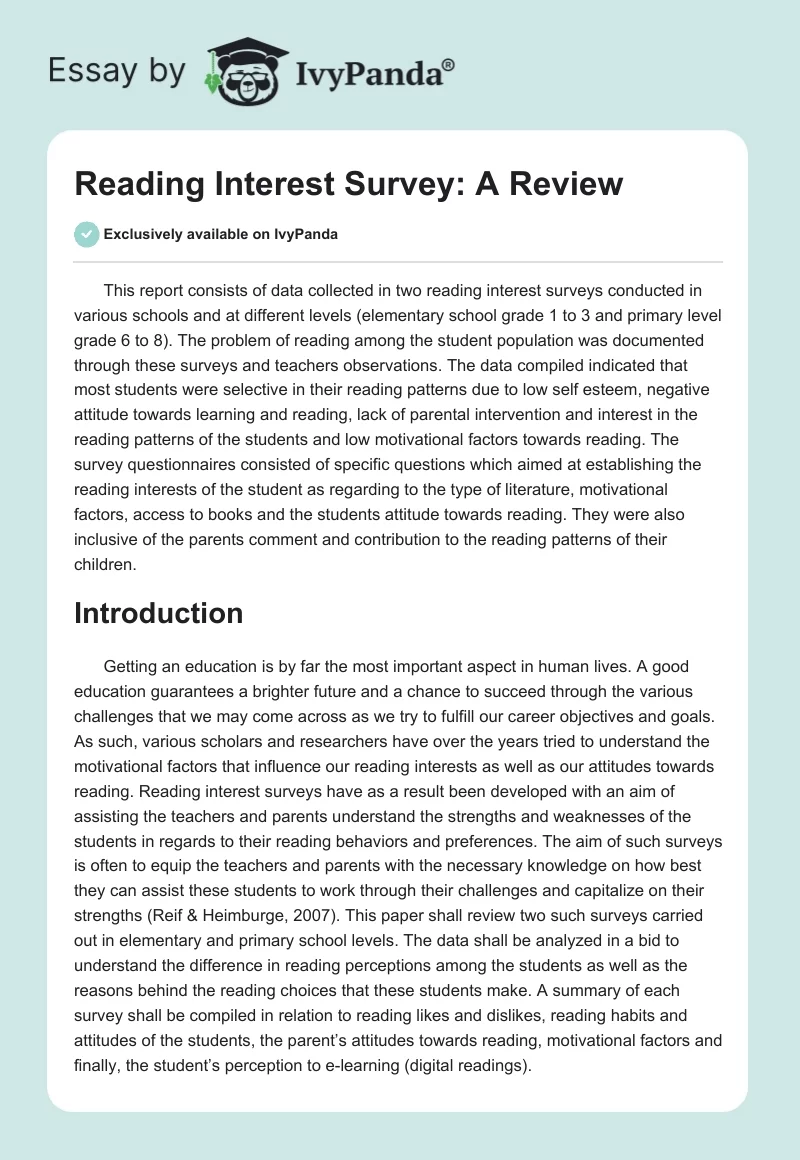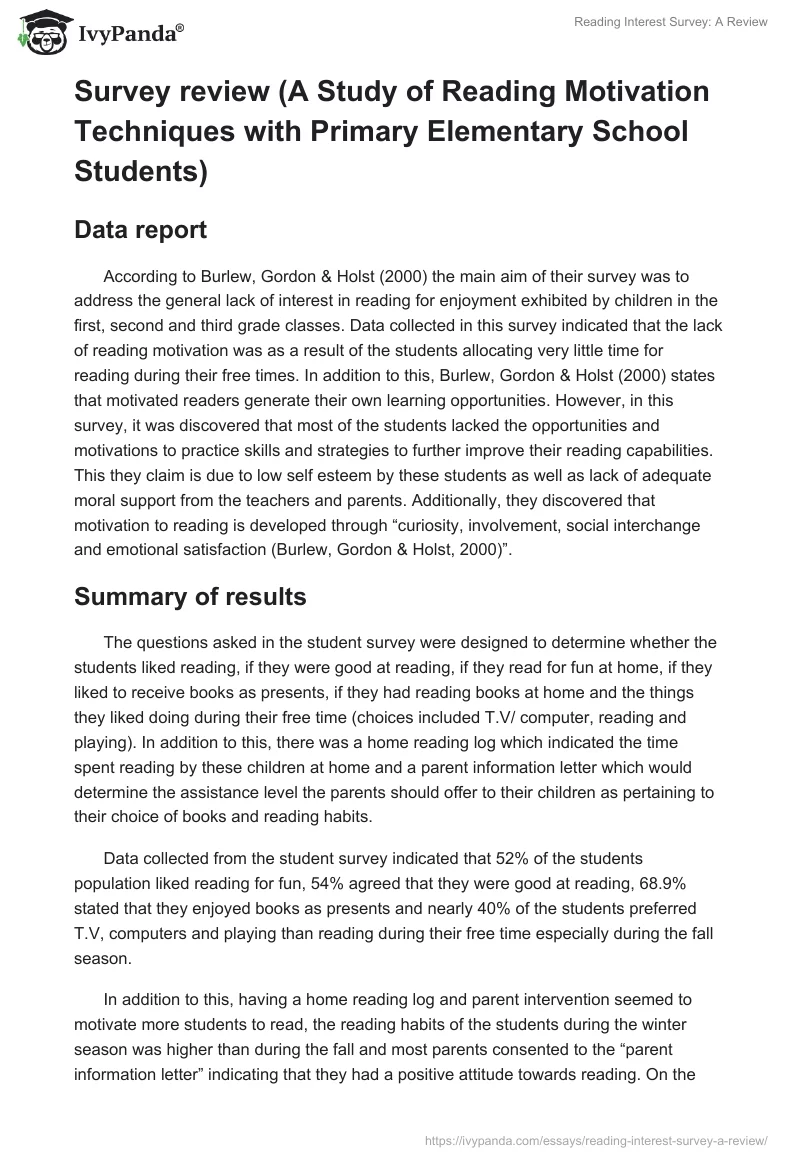This report consists of data collected in two reading interest surveys conducted in various schools and at different levels (elementary school grade 1 to 3 and primary level grade 6 to 8). The problem of reading among the student population was documented through these surveys and teachers observations. The data compiled indicated that most students were selective in their reading patterns due to low self esteem, negative attitude towards learning and reading, lack of parental intervention and interest in the reading patterns of the students and low motivational factors towards reading. The survey questionnaires consisted of specific questions which aimed at establishing the reading interests of the student as regarding to the type of literature, motivational factors, access to books and the students attitude towards reading. They were also inclusive of the parents comment and contribution to the reading patterns of their children.
Introduction
Getting an education is by far the most important aspect in human lives. A good education guarantees a brighter future and a chance to succeed through the various challenges that we may come across as we try to fulfill our career objectives and goals. As such, various scholars and researchers have over the years tried to understand the motivational factors that influence our reading interests as well as our attitudes towards reading. Reading interest surveys have as a result been developed with an aim of assisting the teachers and parents understand the strengths and weaknesses of the students in regards to their reading behaviors and preferences. The aim of such surveys is often to equip the teachers and parents with the necessary knowledge on how best they can assist these students to work through their challenges and capitalize on their strengths (Reif & Heimburge, 2007). This paper shall review two such surveys carried out in elementary and primary school levels. The data shall be analyzed in a bid to understand the difference in reading perceptions among the students as well as the reasons behind the reading choices that these students make. A summary of each survey shall be compiled in relation to reading likes and dislikes, reading habits and attitudes of the students, the parent’s attitudes towards reading, motivational factors and finally, the student’s perception to e-learning (digital readings).
Survey review (A Study of Reading Motivation Techniques with Primary Elementary School Students)
Data report
According to Burlew, Gordon & Holst (2000) the main aim of their survey was to address the general lack of interest in reading for enjoyment exhibited by children in the first, second and third grade classes. Data collected in this survey indicated that the lack of reading motivation was as a result of the students allocating very little time for reading during their free times. In addition to this, Burlew, Gordon & Holst (2000) states that motivated readers generate their own learning opportunities. However, in this survey, it was discovered that most of the students lacked the opportunities and motivations to practice skills and strategies to further improve their reading capabilities. This they claim is due to low self esteem by these students as well as lack of adequate moral support from the teachers and parents. Additionally, they discovered that motivation to reading is developed through “curiosity, involvement, social interchange and emotional satisfaction (Burlew, Gordon & Holst, 2000)”.
Summary of results
The questions asked in the student survey were designed to determine whether the students liked reading, if they were good at reading, if they read for fun at home, if they liked to receive books as presents, if they had reading books at home and the things they liked doing during their free time (choices included T.V/ computer, reading and playing). In addition to this, there was a home reading log which indicated the time spent reading by these children at home and a parent information letter which would determine the assistance level the parents should offer to their children as pertaining to their choice of books and reading habits.
Data collected from the student survey indicated that 52% of the students population liked reading for fun, 54% agreed that they were good at reading, 68.9% stated that they enjoyed books as presents and nearly 40% of the students preferred T.V, computers and playing than reading during their free time especially during the fall season.
In addition to this, having a home reading log and parent intervention seemed to motivate more students to read, the reading habits of the students during the winter season was higher than during the fall and most parents consented to the “parent information letter” indicating that they had a positive attitude towards reading. On the same note, Burlew, Gordon & Holst (2000) reiterates that the fact the students spent most of their free time on the computers is an indication that they preferred e-books and digital readings since the computer has a vast array of knowledge and evokes curiosity among the students.
Conclusion
From this study, it is evident that most students have great interest in reading. However the lack of access to reading materials, motivation, priority, time organization and parental intervention may lead to low self esteem to the students as pertaining to reading and as a result, cause them to dislike reading. As such, it is important that both the teachers and the parents work together to ensure that they understand the children’s reading needs and help them realize them.
Survey review (Middleton-Cross Plains Area School District reading survey)
Data report
This survey was conducted in the Middleton-Cross Plains Area School District in Jan.2010. Data collected comprised of engagement and attitude questions which would provide a qualitative analysis of the reading habits, preferences and general attitude of the students towards reading. The data was evaluated in a percentile form depending on the questions asked and the answers provided by the students. The parameters used in the survey were; no interest, a little interest, some interest, a great deal of interest.
Summary of results
According to the survey, 42% of the students attested that they had a great deal of interest in reading fictional and non fictional books, 38% had some interest, 12% a little interest and 8% had no interest at all in such literature. In addition to this, 28% of the students preferred reading comics and graphic novels while 25% of the surveyed population showed no interest in the same. Also, it was noted that only 18% read newspapers while 38% had no interest in reading the newspapers. As regarding to reading motivations, 30% claimed that the authors of the books they chose to read were not important and only 10% viewed this as a cause to read a book. On the same note, 11% admitted to reading a book due to the cover design while 37% claimed that the cover had little importance as to why they read any book. Also, it was discovered that recommendations offered by friends motivated 40% of the students to read these books. 19% viewed such recommendations as very important, 29% claimed it was a little important and 13% said that it was not at all important.
On the other hand, reading habits exhibited by different students indicated that 60% of the students spent on average 0-30 minutes reading during school days while 19% never read at all. Additionally, 47% confessed to reading outside school for an average of 0-30 for their school work, 8% never read outside school and only 11% read for more that an hour under the same circumstances. Also, the survey data indicated that 29% of the students read for fun while 21% don’t. On the same note, 41% of the surveyed students preferred to read in their spare time at home and during class time, 33% proffered to read at home and 13% read in their spare time. Also, only 35% agreed that they visited the library at least once every month, 16% never went to the library and 24% confirmed that they went once or more times each week to check for reading materials of their choice.
Data regarding the reading attitude of the students in this survey revealed that 43% felt positive about reading (liked reading) while 15% showed little interest and 7% had no interest in reading books. Also, 50% of the students stated that they were excellent readers, 39% said they were good readers with little difficulties and only 3% confessed that they actually struggled to read. On the same note, 41% acclaimed that reading was important to them while 6% said that it was not important. Additionally, 53% of the students indicated that they read because they enjoy reading, gathering new information and doing well in school, 8% said that they read in order to complete school work only and 14% said that they read so that they can complete school work and get descent grades. Conclusively, on matters pertaining to performance, 43% said that they were doing well in school, 3% were struggling, 41% excellent and 13% okay.
As per the preferences and choice of reading material, 36% stated that the material of the book influenced their decision and 13% said that the material was of no consequence to their choices. The survey also indicated that 45% of the total student population enjoyed reading adventure fictional books while 38% of the students showed little interest to romance fictions. Also, 56% of the students did not show any affiliated preference to book types. This means that they could read anything without prejudice or biasness to the theme, topic or type of the books. However, 4% claimed that the type of the book was important.
In regards to e-books and digital text, data collected during the survey indicated that 36% of the students had some interest in online materials, 24% showed a great deal of interest in the same, 29% had little interest and 10% had no interest at all. On the same note, 41% showed no interest in blogs, 30% had little interest and only 9% had a great detail in blogging. Additionally, 36% of the students showed some interest in emails and an equivalent figure had a great deal of interest in the same. This showed that the students in this school were well conversant with the internet and as the results indicate they had some interest in online materials.
The survey did not however cover the family attitude towards reading but from he data collected it is evident that most families encourage a reading culture in their homes. This can be deduced from the fact that 33% of the students preferred to read at home, a considerable figure read for fun and did most of their school work at home.
Conclusion
From this survey, the reading habits, preferences attitude and motivational factors of the students in the Middleton-Cross Plains Area School District have been analyzed. The findings therein indicate that the students in this region have truly grasped the essence of reading. However the teaches and parents should ensure that more is done in order to assist those students with low reading potentials in order to establish a knowledgeable and balanced future for these students.
References
Burlew, W, Gordon, T & Holst, C. (2000). A Study of Reading Motivation Techniques with Primary Elementary School Students. Web.
MCPASD. (2010). Middleton-Cross Plains Area School District reading survey. Web.
Reif, S, A & Heimburge, J, A. (2007). How to reach and teach all children through balanced literacy: user-friendly strategies, tools, activities, and ready-to-use materials. USA: John Wiley and Sons.



